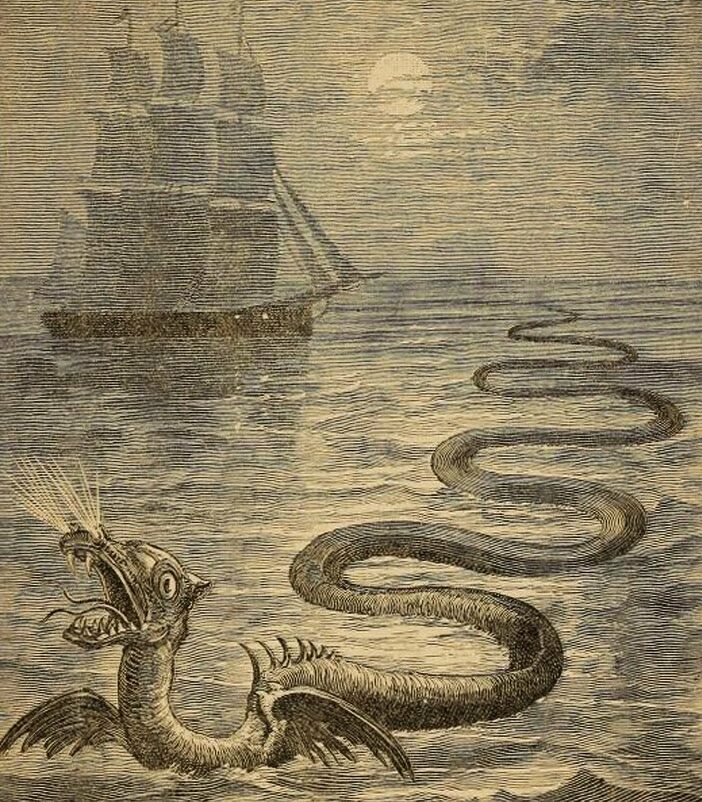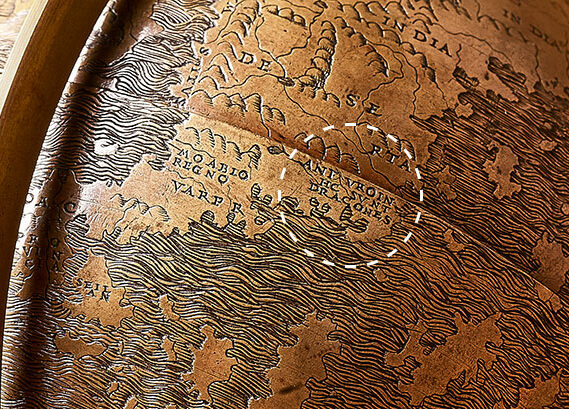The Boundaries between Remote Viewing and other Psychic Work
by Jana Rogge
This article was first published in IRVA’s Remote Viewing magazine Aperture, vol. 35 (Fall 2022).
“Here be dragons” (Latin: hic sunt dracones) means dangerous or unexplored territories, in imitation of a medieval practice of putting illustrations of dragons, sea monsters and other mythological creatures on uncharted areas of maps where potential dangers were thought to exist. [1]
Fifty years ago, a small group of daring scientists set out to explore and survey another mythological area on the map—extrasensory perception. Daring because they were risking their careers by being associated with this “dubious” field of activity. They were not the first to enter this field, but they were essential in building a bridge between myth and science, and in beginning a cartography of this mystic edge of the world.
I see some interesting parallels between this history and the spirit of discovery with which medieval nautical charts were drawn. The discovery of new territories has always been and continues to be associated with overcoming obstacles from within one’s own ranks, as with skeptics, paradigms, ideologies, and a deep-rooted fear of change that clashes with an equally deep-seated curiosity and urge for discovery in the human being, which are the driving forces of development and progress. Both sides of this coin, holding on to the tried and true as well as questioning traditional boundaries, are basic evolutionary principles that enable the survival of our species and are anchored in our inner core. Yet, the obvious problem is that new discoveries always challenge existing structures. For many, this is not just an opportunity, but also a threat that often evokes automatic resistance.
The issue is not only about threatening the integrity of one’s personal worldview, but also, in very practical terms, the vulnerability of existing power structures. Remote viewing ultimately takes this threat to its logical extreme with the prospect of a world without secrets, assuming that it is an innate human ability.
This may be one of many reasons for the everlasting problem of finding sponsors for daring research and expeditions. Columbus, for example, spent 8 years trying to find a financier for his envisioned sailing expedition and received one dismissal after another until the “crazy Italian” found a sympathetic audience with the Spanish king and queen. By the way, even the Spanish king initially rejected the request, and only changed his mind when rumors arose that the archenemy Portugal had captured vast gold resources in Africa and Asia.
This reminds us directly of the effect that intelligence and reports on psychoenergetic research in the Eastern bloc [2] had in the early 1970s, doesn’t it? Again, the threat from the outside was the real driving force behind the willingness to provide government funding for such research. Further parallels in history can be found when looking at how often the RV program had to be defended against skeptics and be rescued, how it passed from one hand to the other and was finally discontinued in 1995. [3] But it wasn’t because this “ship” had not been seaworthy.
To be precise, Columbus’ achievements can at best be called a “rediscovery”—after all, the Vikings had arrived in North America 500 years earlier. Moreover, he reached a land that had been inhabited for thousands of years and had therefore already been discovered—but not yet by the Europeans. In the metaphor I’m using here, these “natives” are the natural psychics, who have known and used this domain since mankind can remember.

It is difficult to provide a satisfactory and simple answer to the question of where exactly the boundaries are between remote viewing and other psychic work.
One of the most prominent misunderstandings is that remote viewing refers to the innate ability of psi functioning and remote perception, rather than just a way of using those underlying abilities. The most important discovery is that ESP is a natural human skill, and its use can be trained like any other human skill. However, this insight followed chronologically only after the coinage of the term “remote viewing.” [4] Consequently, there were different definitions of what was meant by remote viewing depending on historical context. This leads us directly to the issue of distinguishing RV from non-RV, which is an important, if not the central factor in how we understand the discipline.
There are a handful of different definitions of remote viewing, but it is difficult to provide a satisfactory and simple answer to the question of where exactly the boundaries are between remote viewing in all its varying formats and other psychic work. If we could inclusively describe remote viewing in a single sentence, many laborious discussions could be shortened.
The use of scientific protocol elements, such as blinding or feedback, is only part of this answer. Coordinate/Controlled Remote Viewing (CRV), as it was later developed and applied, is a form of the training mentioned above, and at the same time a fully applicable working method. It is the basis or at least the inspiration for nearly all variants and derivatives developed later. One of the core themes of the CRV developed by Swann/Puthoff is how to deal with the phenomenon of Analytical Overlay. The CRV protocol is based on the separation of signal and noise by the viewer. Recognition that AOL exists and applying active methods to filter it out are two of the key features that distinguish protocol-based remote viewing from other forms of psychic work.
The mental process that generates AOL is fundamental—not only a survival mechanism, but a basic building block of our perception and physical existence in the world itself. Our visual perception is a vivid example of this. Even though we think we have a complete visual impression of the world around us, this is not true, technically speaking. Our retinas primarily capture brightness information; the field of view of actual “clear” vision is only as large as a coin. [5] Through a constant involuntary minimal movement of the eyes, [6] combined with the interpolation of the data fragments, a “complete picture” of our surroundings is generated, which in reality exists only virtually in our mind and was never registered by our sensory organs in the detail that we think we perceive. Essentially, our perceptual processes fill in the gaps. So, from the very beginning, we “live” in a world that we perceive as 100% real, but which in fact consists to a large extent of constructed and interpolated data.
Now, we want to teach this mind how to separate signal and noise. This is an exciting endeavor, and the fact that it has succeeded is one of the amazing things about the CRV protocol.
The part of our perception that is responsible for the interpretation and completion of data is active as a biological “basic program,” so to speak. Unfortunately, this is also the main opponent when it comes to filtering “clean data” in remote viewing. Being aware of the problem already helps a lot, but only extensive training and practice leads in the long run to learn to reliably recognize and sort out the friendly help of this “assistant” and to train one’s subconscious to a new way of perception. [7]
 So, you could say remote viewing is a process, where one trains to subdue one of these “survival programs” anchored in us, for a certain period of time, and replacing it with a different behavioral pattern, that exposes an innate human ability, which is usually repressed by the conscious mind.
So, you could say remote viewing is a process, where one trains to subdue one of these “survival programs” anchored in us, for a certain period of time, and replacing it with a different behavioral pattern, that exposes an innate human ability, which is usually repressed by the conscious mind.
Back to the dragons, the white areas on the map and the undiscovered land. Fifty years of RV research have already brought some major insights into the functioning of extrasensory perception. But despite the many questions that have been answered, new questions continue to be raised.
But we have not yet reached our destination. Like the world explorers in Columbus’ time, we are still on the move. But now we are discovering the world on a new and higher level. We are crossing oceans, but this time without getting physically wet. Some see this exploration as a competition, they think they need to stake their claim to these newly discovered lands. When reaching a new coast, they proclaim themselves governors. But, when looked at from a more objective perspective, it becomes clear that we’re all just the same kind of naive sailors in a group of tiny wooden medieval sailing ships, navigating the same ocean as everyone else, and that the new world belongs to no one, yet it belongs to everyone.
In recent years, more and more are gathering on the beaches of the “old world,” raising their eyes to the horizon and being curious about what they think RV is (given their sources of information). They come with different desires and assumptions, and our responsibility is to provide them all with the accurate knowledge of what RV really is (and what it is not), so that they can make their own decisions about where they want to go from there.
Not everyone has the same goals. Some are only looking for the evidence, a first-hand experience that proves that ESP really exists. Others want to answer binary questions as fast and cleanly as possible and have a look into the future. A handful are interested in really using the methodology to gather information and getting really good at it.

“HC SVNT DRACONES” – Engraving on the Hunt-Lenox Globe, one of the first globes to show the New World.
One of the most prominent misunderstandings is that remote viewing refers to the innate ability of psi functioning and remote perception, rather than just a way of using those underlying abilities.
For each of us, there are different ambitions and working areas, different methods: If I only want to cross a lake, maybe a rowboat would be better, and in fact, I may already be almost to the far end of the lake before someone else’s sailing ship has even loosened its lines and weighed anchor. But if the goal is to cross an entire ocean, an ocean liner is what you want, and a rowboat wouldn’t do. So it is with remote viewing methods and applications. Some might be better for one purpose, but not good for others. And vice versa.
Those who spend years of detailed work drawing the charts to the new world, and responsibly resist the temptation to color in the unknown white spots with their speculations, have earned our respect, as have those who return home from spectacular expeditions and contribute with their stories to spreading the word about remote viewing. ■

A traveller puts his head under the edge of the firmament in the original (1888) printing of the Flammarion wood engraving.
Participate in a short survey and tell me what you think about it: How would you define remote viewing in a way that also explains how it is different from other modes of psychic behaviour? www.surveymonkey.de/r/S2RHP6K
Footnotes
[1] Wikipedia
[2] Exemplary sources are Paraphysics R&D—Warzaw Pact (U), originally published in 1978 by DIA, available in the CIA library as a version from NSA, February 1980; H.E. Puthoff, R. Targ, E.C. May, Psychonenergetic Research: Suggested Approaches, SRI International, May 1978; Sheila Ostrander, Lynn Schroeder, Psychic Discoveries Behind the Iron Curtain (first published 1970).
[3] https://psi-unit.com/en/rv/
[4] The term was coined by Ingo Swann, who had demonstrated an ability to accurately “remote view” weather in various American cities in experiments with researcher Gertrude Schmeidler of City College, New York and the American Society for Psychical Research (ASPR).
[5] The two types of receptors, cones and rods, are not evenly distributed in the retina. In the periphery there are primarily rods. In a small central spot— the so-called yellow spot (macula lutea)—the cones cluster. In the center of this spot lies the area of the sharpest vision, that covers a visual field of about coin size.
[6] oculomotor activity, cf. saccades, fixation jumps
[7] Note: Natural psychics do not usually understand how to deal with AOL, yet, like everyone else they experience it when they’re being psychic. What gives us an indication that AOL is indeed an issue is the fact that even with natural psychics, the quality and hit accuracy of their data varies across different sessions. Obviously, they can receive particularly large or good clusters of data at times, when they are particularly well connected to the “signal.”

